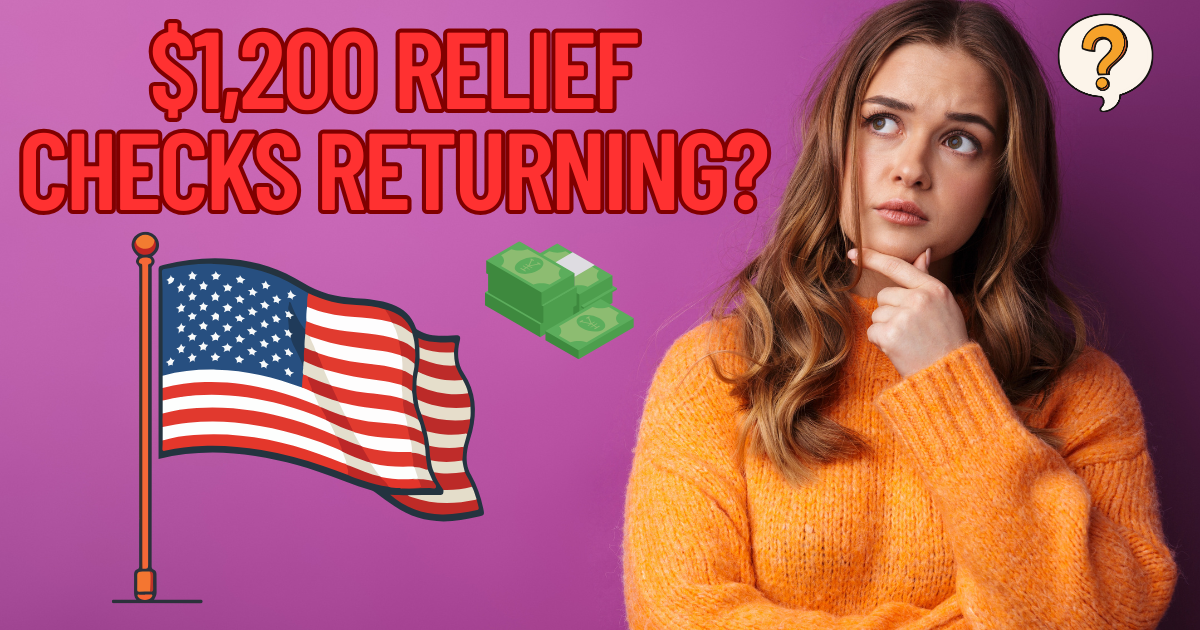$1,200 Relief Checks Returning? What Every Retiree Needs to Know. The government of US provides relief checks to its eligible citizens, particularly those with low incomes. These checks are offered to individuals to help them cover the cost of their daily essentials. This is a crucial payment for those who rely on government benefits for their daily living expenses. To know more about the $1,200 relief checks and what the important details are that every retiree needs to know, read the complete article.
$1,200 Relief Checks Returning?
The IRS is going to distribute $1,200 relief checks to eligible citizens of the The US. These payments are launched to provide financial relief to low-income individuals who are in a vulnerable state and are not able to afford their basic necessities. The $1,200 relief checks offer vital relief for individuals who missed earlier stimulus opportunities. The Internal Revenue Service (IRS) announced in December that it will disburse approximately $2.4 billion—up to $1,200 per applicant—worth of relief checks to US taxpayers who did not claim the Recovery Rebate Credit on their 2021 tax return.

Check Payment Dates
Check New Payment Amount
Check Payment Increase News
Check New Eligibility Criteria
The government needs to offer financial aid to the individuals to keep the country’s economy afloat. However, it is also necessary to receive the authority’s permission before relying on any payment plan. The information has been declared by the US government that the relief checks will be provided to eligible individuals. The payment will get deposited in the bank account of applicants and there is no need to file an application.
Eligibility Criteria
To qualify for this payment, you must fulfill the eligibility criteria given below:
- Income Threshold: Your Adjusted Gross Income (AGI) determines whether you qualify or not. These thresholds assist in prioritizing aid for lower- and middle-income households.
- $75,000 for individuals if filing as single or married filing separately
- $112,500 if filing as head of household and
- $150,000 if filing married filing jointly
An individual’s payment is reduced by 5% of the excess of the individual’s AGI over the applicable threshold.
For eligible individuals with no qualifying children, the payment is reduced to $0 if their AGI is at least: - $99,000 if filing as single or married filing separately
- $136,500 if filing as head of household and
- $198,000 if filing married filing jointly
- Tax History: Eligibility primarily depends on your 2021 tax return. However, the IRS also considers data from your 2023 tax return if your 2021 filing is unavailable.
- Taxpayers who did not claim the Recovery Rebate Credit (RRC) in 2021 are automatically eligible.
- Non-filers may still qualify but must file a simple tax return by April 15, 2025.
- Residency: Citizens of the US, permanent residents or qualifying resident aliens may qualify for the maximum amount of $1,200 for an individual or $2,400 for married individuals filing a joint return. The applicant must also have a legal Social Security Number (SSN)
How to Claim?
There is no need to file an application, as the payment will automatically get deposited in the bank accounts of respective individuals. However, there are a few steps by which you can ensure that you’re completely prepared for the payment.
- Verify Eligibility: It is necessary to verify your eligibility before expecting your payment. Confirm your AGI and filing status. If unsure, review your 2021 and 2023 tax returns or consult a tax professional. You can also use various free tools offered by many digital tax preparation platforms to verify your eligibility.
- Update Information: Keep your information updated to avoid delayed payments. You can update your banking and personal details. Use Form 8822 to inform the IRS of any changes to your mailing address. This is especially important for those who recently moved.
- File a Tax Return: This is the most simple and significant step to get this payment. If you haven’t already filed the tax return by 15 April, 2025, you need to file it. It is advised to file the tax return even if you have no income to receive benefits provided by the government.
- Gather Necessary Documents: You need to gather these necessary documents, as they may be required:
- Your Social Security Number (SSN) or Individual Taxpayer Identification Number (ITIN)
- Records of income (if applicable), such as W-2s, 1099s, or benefit records
- Information about any relief payments you may have got in 2021
- Keep an eye on the Official Website: You need to monitor the official website of the IRS regularly to get all the information about the updates and payments. You can also subscribe to its official newsletters or alerts.


